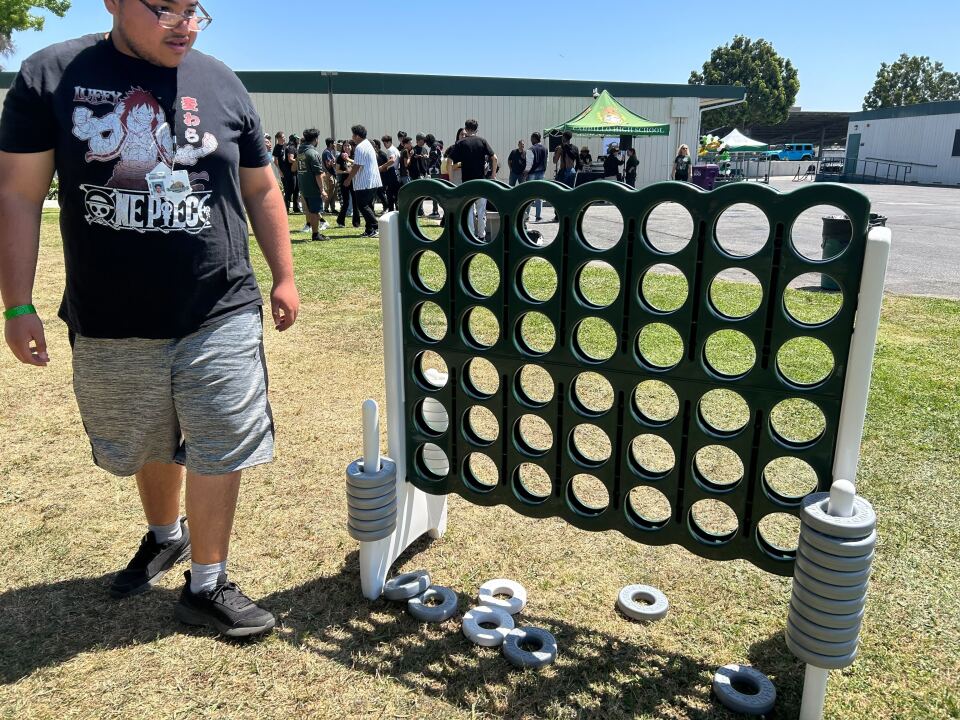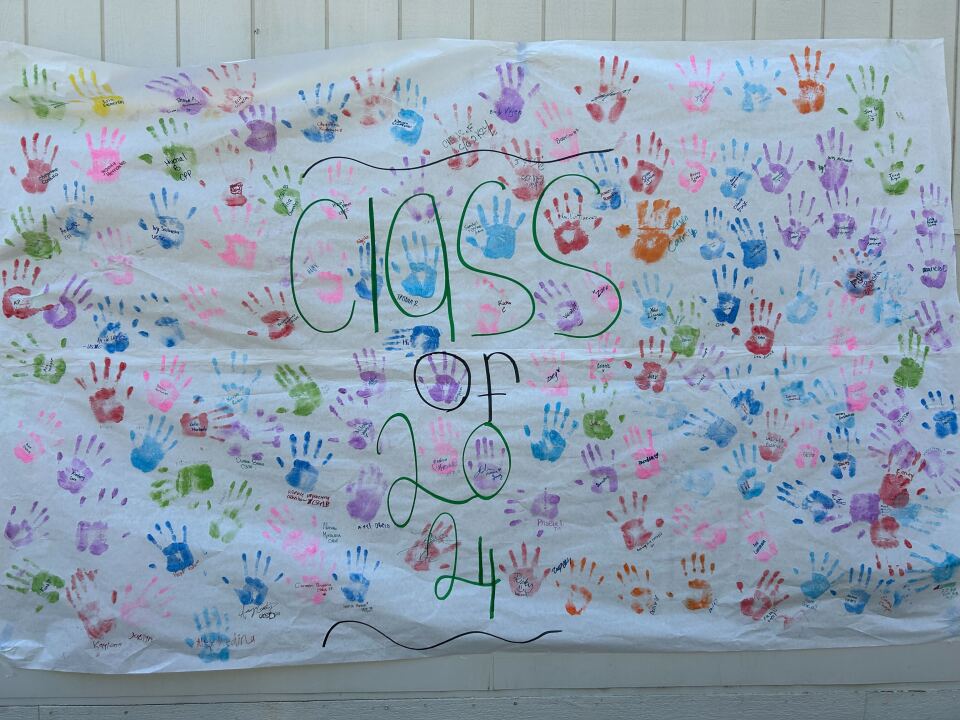Truth matters. Community matters. Your support makes both possible. LAist is one of the few places where news remains independent and free from political and corporate influence. Stand up for truth and for LAist. Make your tax-deductible donation now.
Young men of color struggle to enroll in college. This advising program says its approach works

During a recent lunch, seniors at Cabrillo High School in Long Beach streamed into a grassy area on the north side of campus. A DJ played grupera songs on one end of this quad, a few students tossed bean bags playing cornhole nearby, while others stamped their hand prints in various colors on a large sheet of paper with the words “Class of 2024.”
“I’m going to [Cal State] Dominguez Hills, my major is going to be criminal justice,” said Arturo Magaña.
He’s one of a couple hundred seniors here today to celebrate their education plans after high school, feasting on pizza, chips, and snow cones.
The celebration was organized and paid for by the USC College Advising Corps. The organization trains and assigns at least one recent college graduate to work with all seniors at dozens of L.A. County high schools, with the goal of making college a reality for more students.
Where some students run into problems
Magaña is a member of a key demographic for USC CAC — he's a young man of color, who California’s colleges and universities have struggled to keep enrolled, especially young Black and Latino men. Male-female enrollments among Black and Latino students is lopsided, as much as a 60-40 split of women to men.
How To Get To College In California
Higher education promises a lot of things: jobs, better pay, fantastic opportunities, lifelong success. But trying to make it all happen is, uh, not so straightforward. LAist can't make decisions for you, but our guide to navigating college in California can sketch out the landscape — tell you the basics of what’s out there, highlight helpful resources, discuss pros and cons of different options, get honest about financial aid, and point you to real humans who can talk you through it.
When Magaña thinks of the future, he thinks about his older brother, he said, because their family struggled financially when they were younger.
"We took care of my little sister when she was little, me and my brother, so my mom and dad stepped up and worked,” he said.
The older brother, Magaña said, enrolled at Cerritos College to fulfill his goal to become an engineer, but dropped out after one year because of financial problems.
“He told me, don’t make the same mistake I did, to leave college,” Magaña said.
What's an approach that might work?
USC College Advising Corps leaders say they’re making inroads by turning perceived deficits into strengths.
Of California’s nearly 6 million public school students, 56% are Hispanic/Latino and nearly 5% are Black. At Cabrillo High the proportions are much higher: 76% are Latino and nearly 10% are Black.

The corps sends advisors to nearly 50 other high schools with similar demographics. The group trains its advisors on strategies to change what the group’s leaders say is a deficit approach most adults use to talk to the young men, approaches that send the message that, “I need to fix you, this is how you're wrong, this is the problem in you, this is how you're being the wrong way,” said director Ara Arzumanian.
Arzumanian has studied the challenges young men of color face when they consider post-secondary education. He says it’s a problem in the United States and in other countries.
One of the hurdles is the belief by high school males that college will be a lot like high school.
“If they didn't enjoy that experience, they're not going to be as interested in engaging with it at all,” said Benjamin Robles, assistant program director of USC’s College Advising Corps. “One of the things that we actually focus on is helping students understand that higher education can look like a classroom, can look like a lecture hall, but it could also be a mechanic shop, it could also be learning to be a machinist."
What does it look like on the ground?
There are over 400 seniors at Cabrillo High School this year. The corps says its advisors use various means to meet with students, including classroom presentations, and issuing call slips to excuse a student from a class to talk to an advisor. Advisors persist even if a student says they’re not interested in hearing about post-secondary education.
“Most of my friends, they were drawn into the military… I feel like they were distracted with video games,” said Sebastian Ramirez, one of the two advisors at Cabrillo High School and a recent graduate from California State University, Dominguez Hills.

He graduated from nearby Lawndale High School, a school with demographics similar to those at Cabrillo High. Those friends, he said, didn’t think going to college was “cool” and tuned out when counselors and teachers talked about college.
One of his strategies, he said, is to turn some of the students’ ideas to work in a trade and help them understand how college can help with that goal.
That’s why Cabrillo High senior Richard Mendoza is going to Long Beach City College for auto-tech.
“As a kid, I would really enjoy cars and I really thought it was like something I would enjoy doing and my dad also works in that similar kind of area,” he said.
But is it working?
The corps says it collects a lot of data about how often advisors talk to students and what those students end up doing after their senior year.
According to a 2021 report, the latest available, the program helped over 55,000 students enroll in college in the program’s first eight years. The report says an independent analysis conducted in 2018 found that students who met with program advisors were 18% more likely to apply to college. Program officials say their approach is helping more young men of color with post-secondary education but the report did not speak to that.

Administrators said female students turn out in higher proportions to college advising programs in public schools.
Arzumanian shared data that suggests that of the total one-on-one interactions between advisors and students at all the program schools, 45% of the turnout was male students. And 43% of the male students who met with an advisor filled out at least one college application, just two percentage points below female students — meaning the gap between male and female students seeking college help is narrow, Arzumanian said.
A ripple effect
The benefits of the college advising appear to be having a ripple effect within these students’ families.
Advisors at Cabrillo High School helped convince Arturo Magaña to enroll in college on his way to a career in law enforcement. He holds his older brother’s advice to stick with his college goals as he’s shared the college advisor’s tips with his 16-year-old sister, who’s attending another high school in Long Beach.
“She wants to be like my brother, she wants to be an engineer,” he said.








